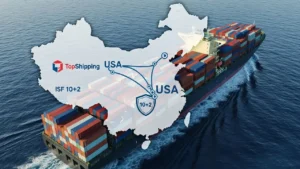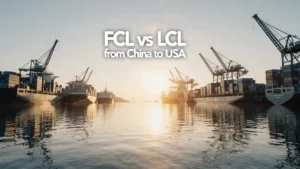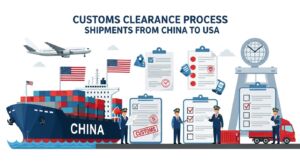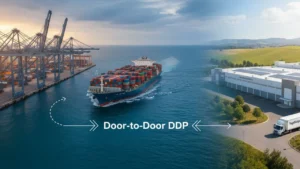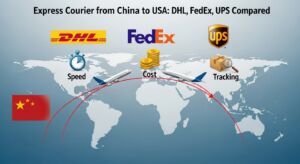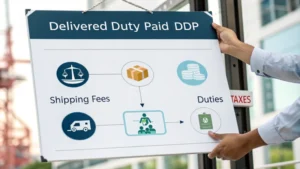What is LTL Shipping?
Less-than-Truckload is a method of shipment of commodities, whereby in case a shipment is insufficient to fill up the whole truck, one can send freight at relatively cheaper costs for small quantities. Whereas Full Truckload freight involves only one shipment utilizing the whole capacity of the truck, LTL consolidates many shipments into one truck. This allows for better utilization of the available space and consequentially reduces costs. It is ideal for a business that does not have to move a lot of items at one given time.
Less-than-truckload shipping involves the consolidation of shipments at a terminal, where shipments are sorted and combined by destination. This can even include transferring shipments across multiple terminals, more commonly known as cross-docking, to facilitate routes more effectively. LTL shipping uses specific dimensions and weight classes to categorize freight, typically best for shipments that range between 150 and 15,000 pounds.
While the former guarantees cost-effectiveness, there is usually longer time consumed to get to a destination due to multiple stops. However, it is also trusted within the whole field of logistics to assist small businesses and
e-commerce retailers in order to manage the shipping cost without sacrificing reliability. Through the partnership with reputable carriers and using advanced tracking, the business can make certain that their LTL shipments are well managed, with more security of the parcels at their destination.
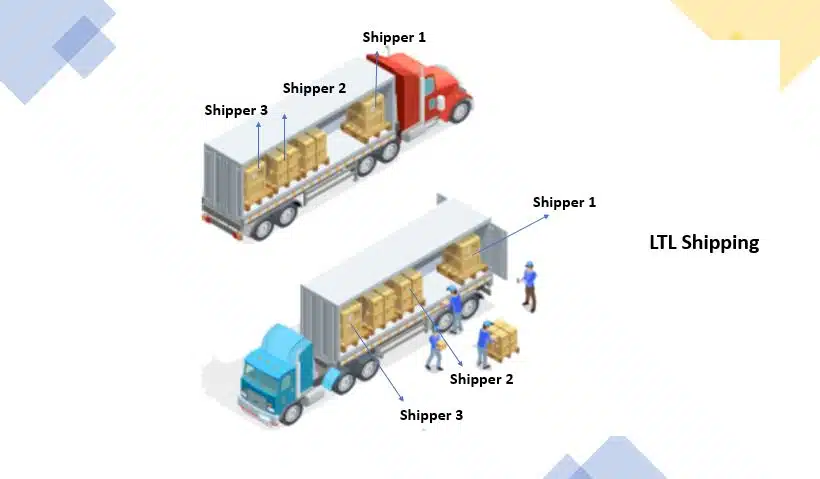
Pros and Cons of LTL Shipping for Businesses
Less-than-truckload shipping has a couple of advantages for a small or medium enterprise and some disadvantages. The most common advantage is that it is cost-effective. A business pays only for the actual space occupied by their freight because there are various shipments combined in one truck. For those businesses that have relatively small shipments, this will indeed be ideal in opening the door for affordable shipping options instead of occupying an entire truck.
Besides that, LTL shipment typically has tracking services that enable the following of shipment processes in real time and enhance customer satisfaction with updates. Generally speaking, LTL carriers have a tendency to make more extra services available, such as liftgates, inside delivery, and residential pickups, while added flexibility can be availed due to diverse shipping needs.
However, there are some disadvantages of LTL transportation. There are typically more stops and a need for consolidation of shipments, which usually means that the transit times are longer compared to FTL shipping. This might be a factor to consider in case delivery speed may be an issue, assuming, of course, that swift transit of the shipment is required. Furthermore, the added handling in terminals increases the possibility of damage, which could be a problem for sensitive items.
It is generally cheaper and allows more flexibility with companies that are not in as much of a rush to deliver products; however, businesses operating on a timeline or with fragile items may view these as potential downsides.
Factors Affecting LTL Shipping Costs
The various factors on which LTL shipment rates depend, if known, can be minimized by a business as much as possible to reduce expenses. Basically, the influencing factors of the cost of LTL shipping are freight class, weight, distance, and accessorial fees.
Freight Class: Shipments fall into different classes depending on their density, value, or handling requirements. Higher freight classes, which involve fragile items or those that hold a high value, are usually more costly because they require special care.
Weight: The heavier the shipment, the more costly it will be. However, LTL rates generally decrease per pound as weight increases. This factor in weight-based pricing can yield cost efficiencies due to shipment consolidation.
Distance: Greater lengths tend to raise the costs since they involve more resources. The strategic partnership with a logistic company like Topshipping will help provide optimized routes to handle long-distance costs.
Accessorial Fees: Added services-liftgate access, residential delivery, or inside delivery-are added to the fees. These have to be scrutinized properly, as most of the time they build up rather quickly.
Cost Savings Tips: Companies can reduce LTL costs by ensuring accurate measurements and packaging of freight to avoid additional volume charges, combining shipments, and considering direct-to-terminal delivery when feasible. Partnering with responsible carriers, such as Topshipping, may also give business enterprise reasonably priced alternatives without compromising quality service and on-time delivery.
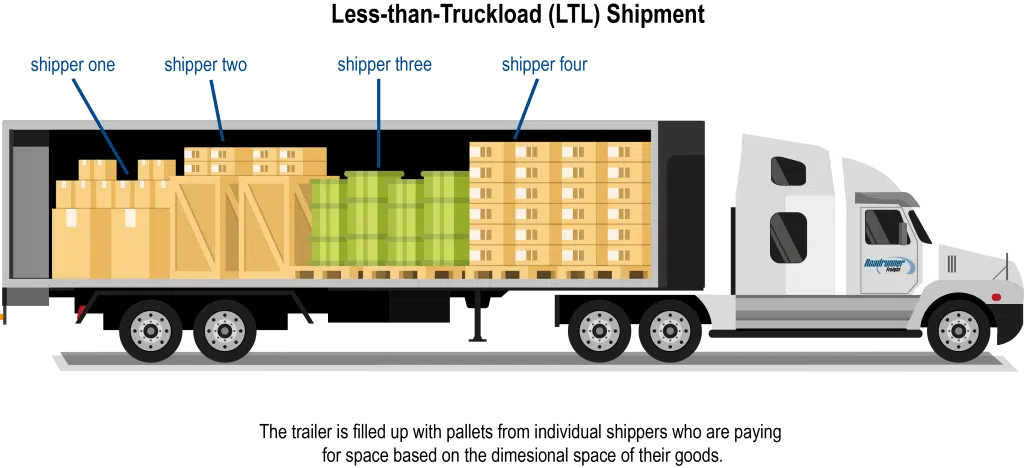
How to Choose the Right LTL Shipping Carrie
The right choice of the less than truckload shipping carrier contributes to on-time and safe delivery, which also turns out to be cost-effective. These factors include network coverage, delivery times, insurance options, and customer service.
Network Coverage:
Carriers should have widespread networks that match customers’ shipping destinations. Such a broad network of carriers allows one to achieve efficiency in routing and saves time and cost for shipment. Topshipping has a very robust coverage, hence efficient coverage of major shipping lanes.
Delivery Times:
Check the average speed of delivery of the carrier, especially if the shipment is time-critical. LTL carriers operate within different transit times; thus, it is for this reason that one has to identify a trucker suitable for his/her scheduling needs while at the same time ensuring the operation is cost-effective.
Insurance Options:
Insurance is meant to cover the shipment of high value or those that are breakable and may get spoiled during deliveries. Here, one has to check the options of insurance the carrier has for its customers, what is covered, and whether there will be any additional insurance required for goods of high value.
Customer Service:
With great customer service, a responsive carrier greatly improves the shipping experience through prompt responses to concerns and real-time updates. Indeed, the best LTL carriers are cognizant of ensuring good communication with their clients throughout transit. This means that, for companies in need of reliability and affordability, selecting a carrier such as Topshipping-assuring extensive coverage and dedicated service-will facilitate logistics and provide peace of mind. Take these factors into consideration and make an informed choice. Get the right fit for your shipping needs.

Differences Between LTL and FTL Shipping: Which Is Right for You?
Knowledge of the differences between LTL and FTL shipping can thus result in proper choice based on cost, speed of delivery, and the size of shipment for businesses.
Cost: LTL tends to be cheaper on shipments that are smaller and don’t fill a complete truck. Since you’ll be sharing space in the truck with other shipments, the cost is divided among more shippers. FTL is almost always better for larger shipments since you’re paying for a complete truck whether you use half the space or not. For large shipments, though, FTL can be much cheaper on a per-unit basis.
Delivery Speed:
Generally speaking, FTL is going to offer faster delivery speeds than LTL. The truck will be making less stops, and thus your goods are taken directly from A to B; the shipments in LTL may have many stops for other shipments, hence increased time on transit.
Size of freight:
For LTL, it’s ideal for businesses that have less volume and smaller, infrequent shipments; these are cargo that does not necessitate the usage of a full truck. FTL is intended for large volume or heavyweight cargo that requires an entire truck.
The choice between Less than Truckload and Full Truck Load depends on the size of the shipment for companies weighing these options, the urgency, and the budget. Topshipping can help businesses make the most viable and efficient decision in terms of cost with regard to their needs.
Understanding Freight Class and Density in LTL Shipping
Freight class and density are two of the most critical determining factors in pricing when it comes to less-than-truckload shipping. These elements help the carriers determine how to move goods in the most efficient and cost-effective way.
Freight Class: Freight class is the system of classifying shipments by four key criteria: density, value, handling, and stowability. Freight classes are rated on a scale from 50 to 500, in which the smaller the number is, the cheaper the shipment is and easier it is to handle. The higher the numbers, the more complicated the freight will be, such as fragile or high-value items. A freight class calculator will give the appropriate way to calculate a business’s correct freight class so that they could be charged for what is proper and not have any unexpected fees.
Density in LTL: The density of a shipment refers to the ratio of its weight to volume (length × width × height). This will, if anything, ensure that the freight class and cost are related to the density of the shipment. Goods high in density-that means, heavier for their size-typically cost less to ship than items that are low in density, since more of them can fit into the truck. Calculating the density correctly helps optimize shipping costs and saves companies from overpaying.
Understanding freight class and how density in LTL shipping works can aid businesses in more accurately estimating shipping expenses, thus avoiding surprises. Consultations with well-seasoned carriers, like Topshipping, will be able to mentor the business through all these complexities when there are doubts.
How to Calculate LTL Shipping Costs?
At Topshipping, we work hard to make Less Than Truckload. straightforward-especially when it comes to understanding the costs. Calculating Less Than Truckload shipping costs requires considering several key factors which will affect your bottom line.
Precise LTL dimensions are very important. Most of the time, a carrier quotes weight and size, so the actual dimensions should be there. If you receive a larger or heavier shipment, that would be more expensive. You can work out using an LTL dimensions calculator, which will work out the right measurements in inches using the same base of knowledge for accuracy.
Freight class also has a profound influence on pricing. This system bases its origin on classifying the type of good, its density, and the amount of susceptibility to damage. The general rule of thumb is that the higher the class, the higher the rate, so proper classification must be done.
Distance between pickups and delivery locations has an effect on the cost. The longer the distance, the more the fees are; there are some possible surcharges for certain routes.
Your budget should also consider accessorial charges, such as liftgate delivery or residential service. Moreover, this is where seeking the best rates by comparing quotes from a range of carriers becomes important.
With the above factors set forth, including LTL length limits and LTL dimensions, you would get to estimate how much it costs to ship with great efficiency and thus make the right decisions for your company. Let us handle the intricacies of shipping so you can do what really matters!
Tips for Reducing LTL Shipping Costs
Even the most seasoned shippers can sometimes stumble when it comes to LTL. Following are some of those common pitfalls and how to avoid them for a generally smooth shipping experience:
Inaccurate Freight Classification
Perhaps one of the biggest mistakes made when it comes to LTL is providing an incorrect freight classification. This can lead to unexpected charges that can throw off your budget and create frustration.
Ensuring Proper Classification
To ward off this, ensure that your freight is correctly classified according to weight, dimension, and any other important factor. This minor checking of freight class will help you keep away from the very expensive re-classification fees and unexpected delays.
Poor Packaging
Another common mistake in shipping cargo is poor packaging. Poorly packaged items may result in damage, increasing costs but also denting your reputation with customers.
Protecting Your Shipment
Every shipment should be made using strong, high-quality packing materials that prevent damage. Extra padding or custom crating for fragile items may be necessary. Proper packaging reflects genuine interest in the quality and safety of your goods and will go a long way toward building trust with your customer and avoiding unnecessary costs from damages.
Advantages and Drawbacks of LTL Shipping:
At TopShipping company, we ship and understand that choosing the right shipping method for your business is important. On one side, LTL shipping also tends to have its share of advantages and disadvantages.
Advantages:
Economically, Less Than Truckload shipping is pretty cheap. Since you share the truck with other shipments, you pay only for part of it that you use. This is suited for a small volume of shipment, which may not require a whole truckload. In addition, LTL is flexible in terms of scheduling. Some options include flexible pickup and delivery times.
It also means more carrier options, translating into service options and competing prices that will ensure the best deal is availed for your shipment.
Drawbacks:
However, it also has some disadvantages. For instance, the transit times are usually longer since cargo truck covers a lot of stops down the way, unlike in full truckload shipping. This may be a setback to your delivery schedules, especially when you need the items urgently. Besides, the risk of damage may perhaps be more because your shipment is handled more while in transit.
LTL Delivery Requirements
Less Than Load delivery is the economical shipping alternative for businesses that have fewer cargo-like freights. Delivering in LTL requires some key requirements to be followed in order to make things work smoothly. First, package your items appropriately to avoid damage on the road. Use appropriate boxes to accommodate the item in them and hold items in place with cushioning materials. Then, provide accurate weight and dimensions since such factors will determine the cost and logistics of the shipment. In addition, ensure that your shipment is well-labeled with the address where it will be delivered and any special handling instructions. Besides that, one should plan in advance the pickups together with the confirmation of availability with your carrier. Lastly, ensure open communication is maintained with your freight provider to instantly address whatever concerns may crop up.
Differences Between LTL Shipping and Other Options:
Less Than Truckload shipping differs from other shipping options, such as Full Truckload (FTL) and parcel shipping, in several key ways:
Shipment Size:
LTL shipments cater for those freights that are greater than the usual parcel shipping, yet too small to warrant the use of a whole truck trailer as would be the case with FTL shipments. FTL shipments are usually undertaken when a shipper has merchandise sufficient to fill a whole truck trailer.
Cost Structure:
The cost of shipping LTL depends upon some variables, including but not limited to weight, dimensions, distance, and freight class. In the case of FTL shipments, quotes are given on the basis of miles shipment transport would take and what size truck it requires. Parcel shipping rates are determined by weight and distance, mainly, and special services-which would include expedited delivery, among other things-are another cost over and above the basic transportation costs.
Handling and Transit Time:
An LTL shipment will take more time compared to an FTL shipment, because the carrier has to make stops along the way because of other pickups and deliveries. Smaller packages would take less time with parcel shipping simply because such services often have solely dedicated delivery networks for the parcels being sent out.
Choosing Between LTL, FTL, and Parcel Shipping:
The choice of the proper way of shipping is very important for your business. If the shipment is less than a full truckload, LTL is an excellent option and will save money by sharing in the space on the truck with others.
Full Truck Load :
For bigger shipments when you require the whole truck to yourself, Full Truck Load offers direct, faster delivery. Shipping by parcel is done for smaller packages or single items that happen to be quite flexible and convenient in several delivery options. Each of them has its positives, depending on the size, urgency, and cost of your shipment. Having grasped this understanding, you will be able to make a very effective option that will suit your needs with much cost efficiency.
In freight forwarding, it is Topshipping that gives the best in the industry. Whether you have an LTL shipment or a full truckload, the services of Topshipping make sure your freight is forwarded both reliably and economically. Offering a series of successful and on-time less than truckload delivery, they ensure your goods are consolidated, packed, and then delivered just as perfectly as expected. If you are in search of a dependable freight forwarder to take care of your cargo needs, then Topshipping would be the final word to assure you of no hassle and seamless LTL shipments.








